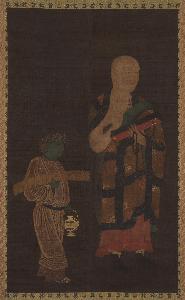Kasuga Motomitsu
None;Kasuga Motomitsu
Place: None
Biography:
Kasuga Motomitsu was a Japanese artist who was active in the early 11th century. He is known for his work in the Kamakura period (1185-1333) and is believed to have created the artwork Portrait of Xuanzang (Genjō) with Attendant in the 14th century. He worked with silk as his medium.
Early Life and Training
Kasuga Motomitsu was born in Japan, where he received training in traditional Japanese art forms. His early work was influenced by the Buddhist art of the time, which emphasized the use of gold and other precious materials to create intricate and detailed designs.
Artistic Style and Techniques
Kasuga Motomitsu's artistic style is characterized by his use of bold colors and delicate lines. He often incorporated traditional Japanese motifs, such as cherry blossoms and dragons, into his work. His use of silk as a medium allowed him to create intricate and detailed designs that were highly prized by the aristocracy of the time.
Notable Works
Some of Kasuga Motomitsu's most notable works include Portrait of Xuanzang (Genjō) with Attendant, which is a masterpiece of Japanese art. This painting, which measures 123.8cm x 74.3cm, is a testament to the artistic excellence of its time. The painting is made on silk and features a beautiful rendering of Xuanzang, a Chinese monk who played a pivotal role in the development of Buddhism in Japan.
- Portrait of Xuanzang (Genjō) with Attendant: This painting is a significant work of art created by Kasuga Motomitsu in the 14th century.
- Kasuga Motomitsu: Kasuga Motomitsu was a Japanese artist who was active in the early 11th century.
- Syrian Desert Evening: This painting is a stunning work of art created by the renowned Japanese artist Ikuo Hirayama.
- Illustrated Biography of Priest Ippen, Vol. 7: This painting is a remarkable handscroll created by the Japanese artist Hōgen En’i during the Kamakura period.
Legacy and Impact
Kasuga Motomitsu's work has had a significant impact on the development of Japanese art. His use of silk as a medium and his bold, delicate designs have influenced generations of artists. Today, his paintings can be found in museums and private collections around the world, including the Fukuda Art Museum in Kyoto, Japan. Kasuga Motomitsu's legacy continues to be celebrated by art lovers around the world, and his paintings remain some of the most highly prized and sought-after works of Japanese art.

